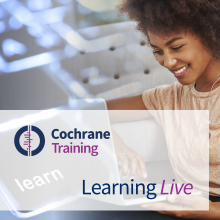
The purpose of this Cochrane Learning Live webinar was to provide up to date guidance for review authors wishing to learn more about developing their own protocol, as well as editors who want to learn more about recognising common errors at an earlier stage in the review process.
Although meta-analyses with very few studies are very common, performing meta-analyses in the case of very few studies remains challenging. The heterogeneity parameter cannot be estimated reliably, the choice between the fixed-effect and random-effects model is difficult, and the use of appropriate random-effects models frequently has very low power.
This Cochrane Learning Live webinar, delivered in January 2023, explained various approaches to performing meta-analyses with very few studies. A framework for choosing a model and selecting an estimation method is described in order to give a useful summary of the study results even if very few studies are available.
The session was aimed at anyone interested in performing meta-analyses in the case of very few studies or wants to assess the adequacy of the methods applied for published meta-analyses with very few studies.
Below you will find the videos from the webinar, together with accompanying slides to download [PDF].
Part 1: Introduction - Models, estimation models, qualitative summary
Part 2: Meta-analysis with very few studies
Part 3: Questions and answers
Presenter Bio
Professor Dr. Ralf Bender is a statistician and epidemiologist with a Diploma in Statistics from the University of Dortmund. He is expert and advisor for the Cochrane Review Group "Metabolic and Endocrine Disorders", Düsseldorf. Since 2004, he is the Head of the Department of Medical Biometry at the Institute for Quality and Efficiency in Health Care (IQWiG) in Cologne, Germany. He is also Professor of Medical Statistics and Epidemiology at the Medical Faculty of the University of Cologne
Part 1: Introduction - Models, estimation models, qualitative summary
Part 2: Meta-analysis with very few studies
Part 3: Questions and answers
Additional materials
Download the slides from the webinar [PDF]
